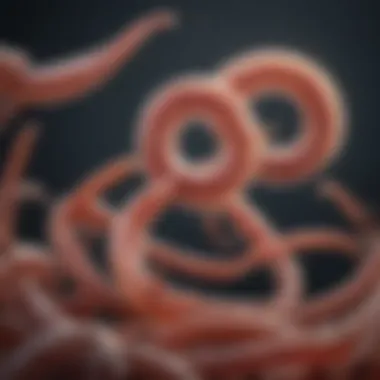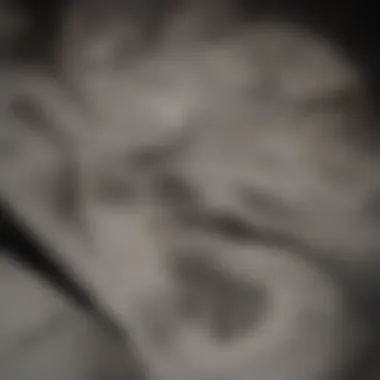OTC Medications for Pinworms: A Comprehensive Guide


Intro
Pinworms, also known as Enterobius vermicularis, are common intestinal parasites, especially among children. Infestations can cause considerable discomfort and embarrassment, yet many people are unaware of the simplicity of effective treatment options available. Understanding how pinworm infections occur, recognizing their symptoms, and knowing the OTC medications that can help provide relief are crucial for managing this health concern.
In many cases, pinworms are transmitted through the fecal-oral route. This often occurs when an infected person does not wash their hands properly after using the bathroom or before handling food. The eggs can also survive on surfaces for extended periods, making it easy for others to become infected. Symptoms of pinworm infection can include intense itching around the anal area, restlessness at night, and in some cases, sleep disturbances.
This guide aims to enrich the reader’s knowledge about the OTC medications available for treating pinworm infections. Through an in-depth exploration of their mechanisms of action, effectiveness, and potential side effects, readers will gain the necessary information to make informed decisions for themselves or for their dependents. With proper understanding and management, pinworm infections can be effectively treated and prevented.
Prelude to Pinworm Infections
Pinworm infections are a prevalent health issue yet frequently underestimated. Understanding this condition is crucial for several reasons. Firstly, pinworms can cause significant discomfort, particularly in children. They may experience itching, irritability, and difficulty sleeping due to the nocturnal activities of these parasites. This guide will provide insights into pinworm infections, empowering readers to recognize symptoms, available treatments, and preventive measures. Moreover, raising awareness about the transmission and lifecycle of pinworms will help inform better hygiene practices and public health initiatives.
Understanding Pinworms
Pinworms, also known as Enterobius vermicularis, are small, white parasitic worms. Adults typically measure about one-third of an inch in length. They inhabit the human intestines, often residing in the rectal area. The adult females lay their eggs outside the anus at night, causing discomfort and itching. This behavior fuels the cycle of infection as individuals scratch the area, transferring eggs to their fingers and subsequently to surfaces or their mouth.
Transmission and Lifecycle
The lifecycle of pinworms is particularly efficient, which enhances their transmission. The process begins with the ingestion of pinworm eggs, often through contaminated hands or surfaces. These eggs hatch in the small intestine, and the larvae migrate to the colon to mature into adult worms. After mating, females lay thousands of eggs around the anal area. This cycle can perpetuate as easily as a person touches an infected area and then engages in activities like eating without proper handwashing. Understanding this cycle is imperative for effective prevention and control measures.
Prevalence of Pinworm Infections
Pinworm infections are notably common across various age groups, particularly among children. Statistics show that millions of people are affected globally, with a higher prevalence in crowded living situations. Daycare centers and schools are hotspots where pinworm transmission can easily occur due to close contact among children. Increased awareness and proper hygiene are essential to decrease the rate of infection. While these infections are generally not severe, they can lead to complications if left untreated, emphasizing the need for prompt action.
It is important to recognize that pinworm infections rarely lead to serious health issues, but they can cause significant discomfort and distress.
In summary, an understanding of pinworms, their lifecycle, and the prevalence of infections sets the foundation for discussing prevention and treatment options. This knowledge is essential for effectively managing pinworm infections.
Symptoms of Pinworm Infections
Understanding the symptoms of pinworm infections is crucial for early identification and effective treatment. Pinworms, while not life-threatening, can cause considerable discomfort and may lead to secondary infections if left untreated. Timely recognition of symptoms allows individuals to seek appropriate OTC medications or medical advice. This can mitigate the risk of spreading the infection to others, particularly in communal living situations like schools or daycare facilities. Furthermore, informing oneself about the symptoms can empower individuals to engage in better preventive measures.
Common Symptoms
Pinworm infections often present a variety of symptoms, most notably:
- Itching around the anus: This is the hallmark symptom of pinworms, usually experienced at night when female worms come out to lay their eggs. The itching can be intense, leading to discomfort and sleep disturbances.
- Restlessness during sleep: Due to the discomfort caused by itching, children may exhibit restlessness, waking frequently throughout the night.
- Irritability or behavioral changes: Sleep disruption can contribute to irritability in children, making them appear cranky or less focused during the day.
- Visible worms: Sometimes, adult pinworms can be seen in the anal region or in the stool. They look like small, white threads and can be a clear indication of an infection.
- Abdominal pain and nausea: Although less common, some individuals may experience gastrointestinal symptoms such as pain or nausea.
These symptoms can vary in intensity, and it is important to monitor for any signs that suggest an active pinworm infection. Recognizing these signs early leads to quicker intervention, lowering the risk of further complications.
When to Seek Medical Advice
While OTC medications can effectively treat pinworm infections, certain circumstances necessitate professional medical advice. Consider seeking medical help if:


- The symptoms persist for more than a few weeks despite self-treatment.
- Severe abdominal pain or other gastrointestinal issues arise, as these could indicate other underlying conditions.
- Secondary infections develop from scratching, leading to signs of inflammation or infection, such as redness, swelling, or drainage from the anal area.
- You are unsure about the right medication or dosage, especially in vulnerable populations like young children or pregnant individuals.
- The infection appears to be recurrent, suggesting a need for a thorough evaluation of hygiene practices or environmental factors contributing to reinfection.
It is always better to err on the side of caution. Consulting with a healthcare professional ensures the most effective and safe management of pinworm infections. Awareness of symptoms and timely action can significantly enhance the quality of life for those affected by pinworms.
"Early recognition of pinworm symptoms is key to preventing complications and promoting overall well-being."
OTC Medications for Pinworm Treatment
Pinworm infections are a common issue that can cause significant discomfort and distress. Over-the-counter (OTC) medications serve as a frontline defense, enabling individuals to self-treat without the need for a prescription. Understanding the available OTC options for treating pinworms is essential for prompt and effective care. These medications are designed to eliminate the infection while being accessible and relatively straightforward to use.
There are key benefits to consider when exploring OTC medications for pinworm treatment. Firstly, they offer convenience; individuals do not need to schedule a doctor's visit to obtain treatment. Secondly, these medications are typically safe for most age groups when used according to instructions. This leads to a sense of autonomy for patients, as they are empowered to take control of their health.
However, caution is still advisable. While OTC treatments can be effective, they can come with potential side effects. Informed decision-making regarding the right medication is crucial, as it affects efficacy and safety. Keeping abreast of the latest information and recommendations surrounding these treatments can greatly enhance an individual's ability to manage pinworm infections successfully.
Types of OTC Medications
There are specific OTC medications available that target pinworm infections. The two main active ingredients in these medications are pyrantel pamoate and mebendazole. Both are effective in killing adult pinworms and preventing further reproduction.
- Pyrantel Pamoate: This is often favored for its ease of use in children and is available in liquid and tablet forms. This medication works by paralyzing the pinworms, allowing them to be expelled from the body during bowel movements.
- Mebendazole: Available mainly in tablet form, mebendazole functions by inhibiting glucose uptake by the worms, eventually leading to their death. This medication is noted for its efficacy, with reports indicating high success rates when taken as directed.
Mechanism of Action
The effectiveness of these medications hinges on their specific mechanisms of action. Understanding how they work provides insight into why they are reliable options for treatment.
- Pyrantel Pamoate works by paralyzing the adult pinworms, interfering with their neuromuscular function. Once paralyzed, the worms can no longer attach to the intestinal wall and are eliminated from the body through natural excretion.
- Mebendazole, on the other hand, directly affects the energy metabolism of pinworms. It reduces their ability to absorb nutrients, leading to their eventual demise as they are deprived of essential resources. Efficacy is maximized when the treatment is taken consistently as prescribed, which highlights the importance of adherence to dosage instructions.
Dosing Information
Proper dosing is critical for the success of OTC medications for pinworm infections. Miscalculations or misunderstandings can lead to suboptimal treatment outcomes.
- For Pyrantel Pamoate, the standard dose for adults and children over two years old is based on body weight, typically calculated at 11 mg per kilogram of body weight. It is important to avoid exceeding the maximum recommended dosage and to repeat the treatment after two weeks if symptoms persist.
- For Mebendazole, the usual adult and child dose is a single 100 mg tablet, which may require a second dose after two weeks to ensure comprehensive treatment. Some instances may warrant up to 200 mg for adults, under the guidance of a healthcare professional. This underscores the necessity of reading the instructions on the packaging carefully and consulting with a healthcare provider when in doubt.
Always consult a healthcare provider if symptoms do not improve or worsen after starting treatment.
Effectiveness of OTC Treatments
Understanding the effectiveness of over-the-counter (OTC) treatments for pinworm infections is essential for individuals affected by this common parasitic condition. Pinworms, while often seen as a minor nuisance, can lead to discomfort and sleep disturbances, affecting the overall quality of life. Effective treatment can not only alleviate these symptoms but also prevent reinfection and further spread within households and communities.
OTC medications can offer several benefits. They are easily accessible, generally affordable, and do not require a prescription. This convenience encourages timely treatment, which is vital given how quickly pinworm infestations can proliferate. Furthermore, the effectiveness of these medications is supported by clinical studies and anecdotal evidence from users.
Yet, it is important to consider various factors when evaluating the effectiveness of OTC treatments, including the active ingredients, dosage instructions, and individual patient needs. Each product may vary in its mechanism of action and suitability, depending on the severity and duration of the infection. Thus, understanding these aspects contributes to making informed treatment choices.
Clinical Studies and Outcomes
Several clinical studies have examined the effectiveness of OTC medications for pinworm treatment. Most studies focus on the active ingredients commonly found in these products, such as mebendazole and pyrantel pamoate. For instance, one study indicated that mebendazole had an efficacy rate of approximately 95% in treated subjects. This high success rate often results from a single dose, which simplifies treatment adherence for patients.


Another key finding highlights the impact of treatment timing. A study showed that initiating treatment during peak pinworm activity—usually at nighttime—could significantly enhance outcomes.
It is crucial to note that while these OTC medications are effective, careful attention to hygiene and follow-up treatment may also be needed to eliminate the infection entirely or prevent reinfection.
Success Rates for Various Medications
While the efficacy of OTC treatments for pinworms is widely recognized, success rates can vary depending on the specific medication used. Here’s a summary of the success rates of popular OTC medications for pinworm treatment:
- Mebendazole: 95% success rate with proper dosing, often needing a second dose two weeks later to eradicate any remaining eggs.
- Pyrantel Pamoate: 90% success rate; effective against adult worms but less so for eggs, which may require additional hygiene measures.
- Levamisole: Less common but noted for a similar success rate; usually indicated when other medications are not suitable.
"Maintaining a clean environment and proper treatment adherence significantly impacts the success of OTC medications for pinworms."
Potential Side Effects
Understanding the potential side effects of over-the-counter (OTC) medications for pinworm infections is crucial for anyone considering treatment options. While these medications are typically effective and widely accessible, they can come with risks that require awareness and consideration. Side effects may vary depending on the specific medication used and the individual taking it. Knowledge about these effects can lead to safer use and better health outcomes.
Overview of Common Side Effects
Common side effects associated with OTC medications for pinworms include:
- Nausea: Some users may experience a feeling of discomfort in the stomach, sometimes leading to vomiting.
- Diarrhea: Changes in bowel movements may occur in some individuals, often resulting in loose, watery stools.
- Abdominal Pain: Cramping or pain in the stomach area can be a reaction to the medication, typically mild and temporary.
- Headache: Some people report headaches after taking pinworm treatments, possibly due to the body adjusting to the medication.
These effects are generally mild and resolve quickly. However, monitoring symptoms is essential, as they can indicate how well a person tolerates the medication. Individuals should consult healthcare professionals if side effects persist or worsen, as this can help prevent more serious complications.
Severe Reactions and What to Watch For
Although severe reactions to OTC medications for pinworms are uncommon, they can occur. It is important to be aware of the signs and symptoms that indicate a serious allergic reaction or other complications. Some severe reactions to be mindful of include:
- Rash or Hives: Development of a rash, especially if it covers a large area, can indicate an allergic response.
- Swelling of Face or Throat: Any swelling in these areas can block breathing, requiring immediate medical attention.
- Shortness of Breath: A feeling of tightness in the chest or difficulty breathing can signify a serious reaction that needs urgent care.
- Severe Abdominal Pain: If abdominal pain escalates significantly, it may be a sign of a serious condition that requires medical evaluation.
Always seek medical advice promptly if severe reactions occur following the use of OTC pinworm treatments. Early intervention can prevent serious outcomes.
Individuals considering OTC medications for pinworms should weigh the benefits against these potential side effects. Those with existing health conditions or allergies should consult a healthcare provider before usage to minimize risks.
Home Remedies and Alternatives
The topic of home remedies and alternatives deserves attention when discussing pinworm infections. Many individuals are seeking less conventional ways to manage ailments, often due to concerns about the side effects of pharmaceuticals. Home remedies can be appealing as they tend to be more natural and perhaps more acceptable for those wary of chemical interventions. This section examines both natural remedies and lifestyle changes that may serve to mitigate the risk of pinworm infestations and can complement over-the-counter treatments.
Natural Remedies
Various natural remedies have gained popularity among those looking to combat pinworm infections. These remedies are often based on traditional practices and can provide some additional support besides OTC medications. Some notable options include:
- Garlic: Known for its antiparasitic properties, consuming raw garlic or taking garlic supplements may help in reducing pinworm populations in the intestines.
- Pumpkin Seeds: This common food contains compounds that might paralyze these worms, making it easier for the body to expel them. Eating a handful of raw seeds regularly could be beneficial.
- Turmeric: This spice has been praised for its anti-inflammatory and antimicrobial properties. Incorporating turmeric into meals may help in creating a less favorable environment for the pinworms.
- Apple Cider Vinegar: Mixing this vinegar with water can create an acidic environment that may inhibit the growth of pinworms. Some suggest consuming a tablespoon daily to support overall gut health.


While these remedies may not be scientifically proven to eliminate pinworms, they can be part of a broader strategy for managing infections. It's also essential to consult a healthcare provider before trying new natural remedies, especially if taking other medications.
Lifestyle Changes for Prevention
Prevention is crucial in managing pinworm infections, especially in environments where transmission is common, such as homes with multiple children. Implementing certain lifestyle changes can significantly reduce the chances of contracting or spreading pinworms. Here are several practical measures:
- Hygiene Practices: Establishing rigorous hygiene routines is vital. Regular handwashing with soap and water, particularly after using the restroom and before meals, can drastically decrease the risk of transferring pinworm eggs.
- Proper Nail Care: Keeping nails short and clean discourages pinworm eggs from lodging underneath nails, where they can be transferred to the mouth during eating or other activities.
- Regular Washing of Bedding and Clothes: Frequent washing of bed linens, towels, and clothing in hot water can kill any pinworm eggs that may be present in these items.
- Avoiding Close Contact: Especially for infected individuals, avoiding close contact with others can help prevent spreading the infection. Using separate towels and not sharing personal items like combs is advisable.
Regular implementation of these changes not only aids in prevention but also builds a cleaner living environment, reducing the risk of many infections.
In summary, while OTC medications are essential for treating pinworm infections, exploring home remedies and making lifestyle adjustments can provide further protection and support. Each individual may require a tailored approach based on their health needs and environment. Always consider consulting with a healthcare professional to discuss the best strategies for pinworm management.
Prevention Strategies
Effective prevention strategies are crucial in the management of pinworm infections. As pinworms are highly contagious, understanding proper preventive measures can significantly reduce the risk of transmission. These strategies involve both personal hygiene practices and broader public health measures, which together create a comprehensive shield against infection.
Hygiene Practices to Implement
Implementing diligent hygiene practices is the first line of defense against pinworm infections. Here are key practices that everyone should adopt:
- Regular Handwashing: Wash hands with soap and warm water frequently, especially after using the toilet, changing diapers, and before meals. This removes any potential eggs that may be present on the hands.
- Nail Care: Keep fingernails short and clean to minimize the chance of eggs accumulating under the nails. Regular nail trimming reduces the risk of accidental ingestion.
- Daily Bathing: Encourage daily baths, particularly for children, as this helps remove any eggs that might be on the skin or in the anal area. Even a quick rinse can be effective.
- Changing Underwear: Change underwear daily and consider wearing tight-fitting underwear to help prevent the spread of eggs.
- Laundering Linens: Wash bed linens, towels, and pajamas frequently in hot water to kill any eggs. Regular washing minimizes reinfection or cross-contamination between family members.
Public Health Measures
Public health measures play a key role in preventing widespread outbreaks of pinworm infections. These measures can include:
- Community Awareness Campaigns: Educating the public about pinworm infections, their transmission, and prevention methods can greatly lower infection rates. Schools and community centers should provide materials on hygiene practices.
- School Health Programs: Schools can implement health programs to teach children about handwashing and personal cleanliness, ensuring proper hygiene methods are widely taught.
- Monitoring Infection Rates: Health authorities should monitor instances of pinworm infections within communities. Early detection can lead to prompt educational interventions to prevent further spread.
- Collaboration Between Health Departments: Collaboration between public health departments and healthcare providers ensures that they can respond quickly to outbreaks and manage resources effectively.
Adopting both personal and community hygiene measures can significantly decrease the transmission and prevalence of pinworm infections, promoting overall public health.
By prioritizing hygiene practices and public health measures, the risk of pinworms can be significantly reduced. Individuals can take proactive steps to protect themselves and contribute to the health of their communities.
The End and Recommendations
In addressing pinworm infections, utilizing the correct over-the-counter (OTC) medications is essential. This article highlights various treatments, emphasizing the need for a comprehensive understanding of their efficacy, potential side effects, and accompanying preventive measures. A thorough understanding aids in making informed decisions, benefiting both individual health and public well-being.
Summary of Findings
The key points established throughout this guide underscore the capabilities and limitations of OTC medications for treating pinworms. Recognizing the typical symptoms and knowing when to seek medical advice assists in prompt and proper treatment. The effectiveness of various medications, such as Pyrantel Pamoate and Mebendazole, shows promise but also carries potential side effects. Moreover, maintaining high hygiene standards can significantly lower the chances of re-infection among household members.
- OTC Options: Pyrantel Pamoate and Mebendazole are potent treatments available over-the-counter.
- Effectiveness: Both medications have demonstrated success in clinical studies, yet adherence to dosing instructions is vital.
- Side Effects: The adverse reactions vary but are generally mild, which necessitates awareness of possible severe reactions.
Final Thoughts on OTC Medications
Choosing OTC medications for pinworm treatment should come from careful consideration of the guidelines discussed. While these medications offer effective solutions for most people, consulting a healthcare provider may be beneficial, especially for vulnerable populations, such as children and pregnant women. Effectiveness, safety, and adherence to hygiene practices play a crucial role in addressing pinworm infections properly.
It is essential to continue fostering education around this common infection, ensuring that reliable information is available to the public. By empowering individuals to understand their options and recognize symptoms early, health outcomes can improve significantly. \n
"Knowledge is the first step toward effective management of health concerns."
Overall, the strategic use of OTC medications coupled with preventive measures creates a solid foundation for managing pinworm infections.















